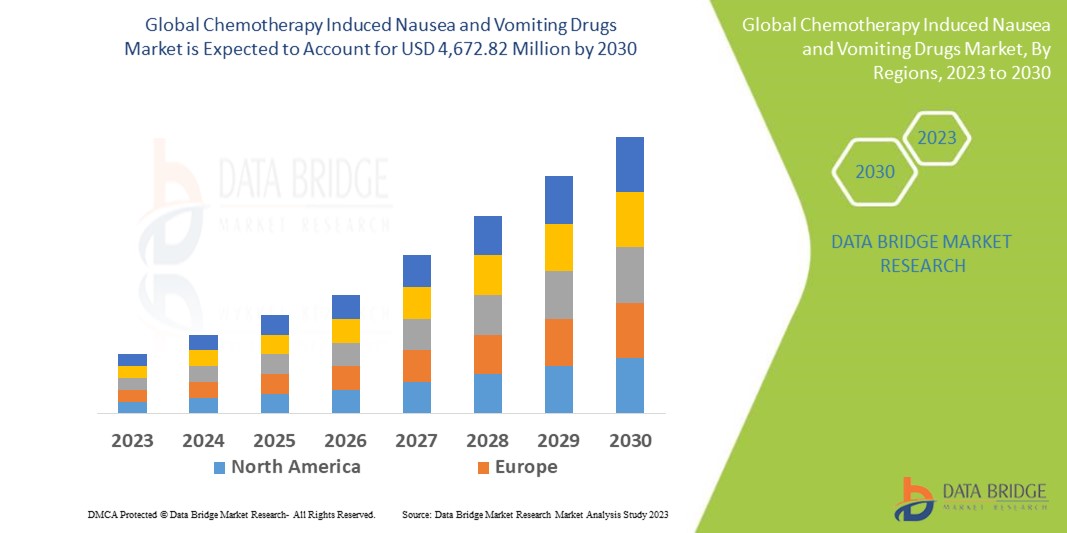
Introduction
The Chemotherapy Induced Nausea and Vomiting Drugs Market is a critical segment of the pharmaceutical industry, addressing one of the most distressing side effects of cancer treatment. Chemotherapy-induced nausea and vomiting (CINV) can significantly impact a patient’s quality of life, leading to poor treatment adherence and reduced therapeutic efficacy. The market for drugs targeting CINV has evolved substantially, driven by advancements in drug formulations, increasing cancer prevalence, and growing awareness among healthcare providers and patients.
The Evolution
The management of CINV has undergone a remarkable transformation over the years. Initially, patients relied on basic anti-nausea medications with limited effectiveness. The introduction of serotonin (5-HT3) receptor antagonists and neurokinin-1 (NK1) receptor antagonists marked a significant breakthrough, providing targeted relief and reducing both acute and delayed nausea and vomiting episodes. The development of combination therapies further enhanced treatment outcomes, ensuring better symptom control with minimal side effects.
Market Trends
Several key trends are shaping the Chemotherapy Induced Nausea and Vomiting Drugs Market:
- Increased Adoption of Combination Therapies: Healthcare providers are increasingly prescribing multi-drug regimens to maximize efficacy.
- Advancements in Drug Formulations: Long-acting oral formulations, transdermal patches, and subcutaneous injectables are gaining popularity.
- Integration of Digital Health Solutions: AI-powered clinical decision support systems are being used to optimize antiemetic regimens.
- Growing Focus on Personalized Medicine: Pharmacogenomic testing is helping tailor treatments based on individual genetic profiles.
Challenges
Despite significant progress, the market faces several challenges:
- High Treatment Costs: Advanced antiemetic therapies can be expensive, limiting accessibility for some patients.
- Regulatory Hurdles: Stringent approval processes for new drugs can delay market entry.
- Side Effects and Drug Interactions: Some antiemetic drugs may cause adverse effects or interact with chemotherapy agents.
- Limited Awareness in Developing Regions: Lack of awareness and inadequate healthcare infrastructure can hinder market growth.
Market Scope
The Chemotherapy Induced Nausea and Vomiting Drugs Market encompasses a wide range of drug types, including:
- Serotonin (5-HT3) Receptor Antagonists
- Neurokinin-1 (NK1) Receptor Antagonists
- Cannabinoid-Based Therapies
- Corticosteroids and Dopamine Antagonists
The market serves various end-users, including hospitals, specialty clinics, and home healthcare providers. Distribution channels include hospital pharmacies, retail pharmacies, and online platforms.
Market Size and Factors Driving Growth
The market is experiencing steady growth, driven by several factors:
- Rising Cancer Incidence: Increasing cancer cases worldwide are fueling demand for effective antiemetic drugs.
- Advancements in Drug Development: Continuous research and innovation are leading to more effective treatment options.
- Improved Patient Compliance: Enhanced drug formulations are making treatments more convenient and tolerable.
- Government Initiatives and Funding: Support for cancer treatment programs is boosting market expansion.
Conclusion
The Chemotherapy Induced Nausea and Vomiting Drugs Market is a vital segment of the pharmaceutical industry, addressing a significant need among cancer patients. With ongoing advancements in drug development, personalized medicine, and digital health integration, the market is poised for continued growth. Overcoming challenges such as high costs and regulatory barriers will be essential in ensuring broader accessibility and improved patient outcomes.
Other Trending Reports :
Global Energy Recovery Ventilator Market – Industry Trends and Forecast to 2030
https://www.databridgemarketresearch.com/reports/global-energy-recovery-ventilator-market
Global Gas Hydrates Market – Industry Trends and Forecast to 2030
https://www.databridgemarketresearch.com/reports/global-gas-hydrates-market
Global Coated Paper Market – Industry Trends and Forecast to 2030
https://www.databridgemarketresearch.com/reports/global-coated-paper-market
Global Drone Taxi Market – Industry Trends and Forecast to 2030
https://www.databridgemarketresearch.com/reports/global-drone-taxi-market
Global Bluetooth Headphones Market – Industry Trends and Forecast to 2029
https://www.databridgemarketresearch.com/reports/global-bluetooth-headphones-market
Global Distillers’ Grains Market – Industry Trends and Forecast to 2029
https://www.databridgemarketresearch.com/reports/global-distillers-grains-market
Global Automotive Elastomer Market – Industry Trends and Forecast to 2029
https://www.databridgemarketresearch.com/reports/global-automotive-elastomer-market
Global Diamond Coatings Market – Industry Trends and Forecast to 2029
https://www.databridgemarketresearch.com/reports/global-diamond-coatings-market
Global Primary Mediastinal Large B-cell Lymphoma Treatment Market – Industry Trends and Forecast to 2029
https://www.databridgemarketresearch.com/reports/global-primary-mediastinal-large-b-cell-lymphoma-treatment-market
Global Non-Thermal Processing For Food Market – Industry Trends and Forecast to 2029
https://www.databridgemarketresearch.com/reports/global-non-thermal-processing-for-food-market